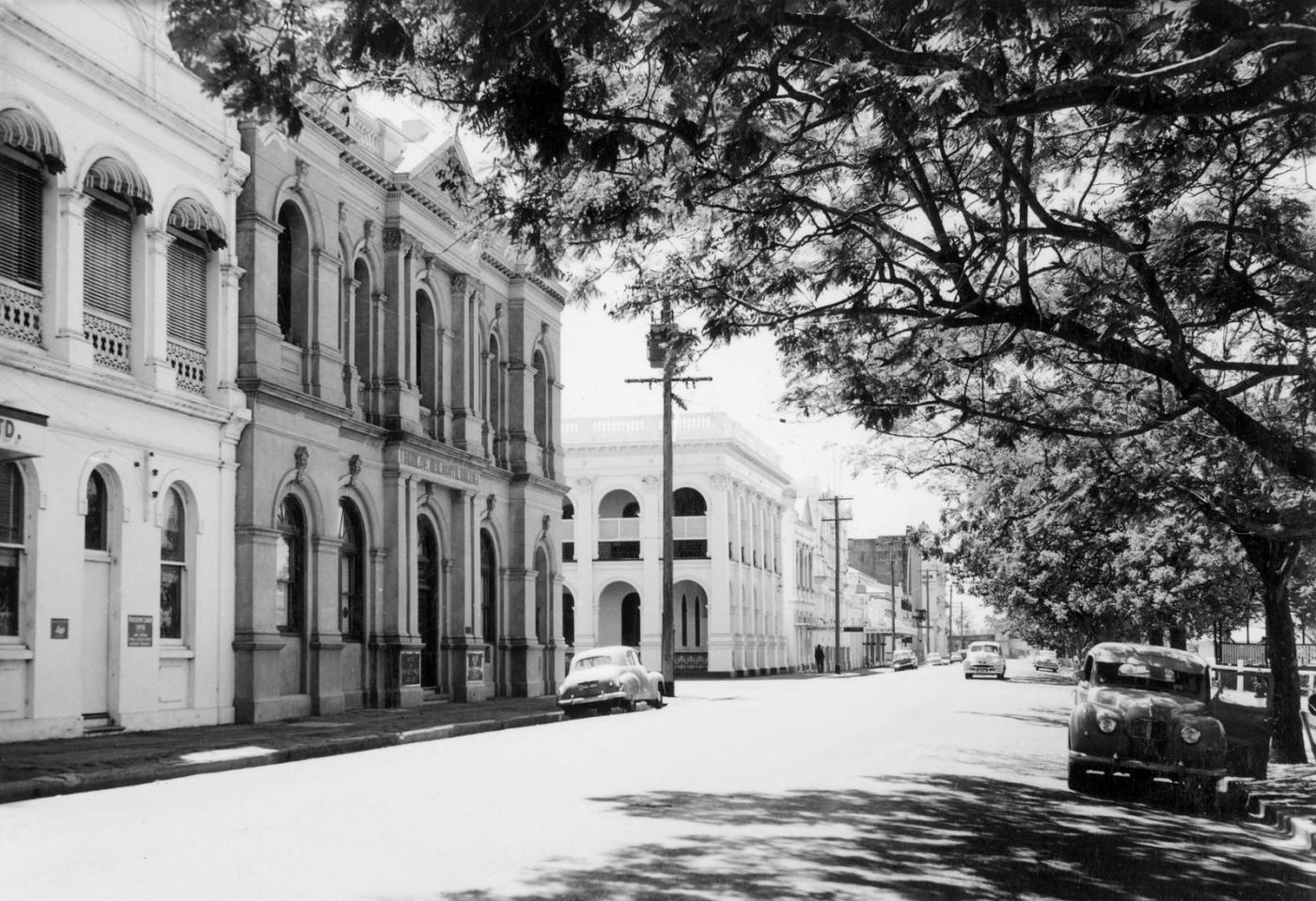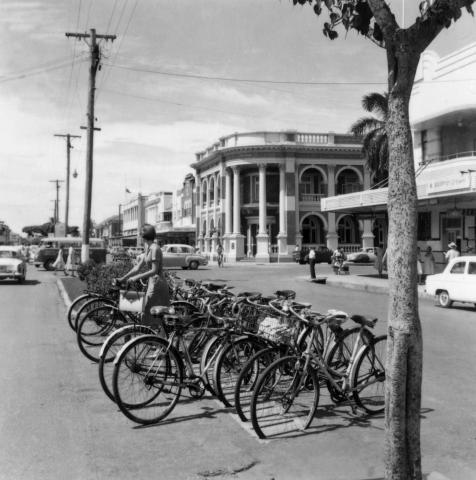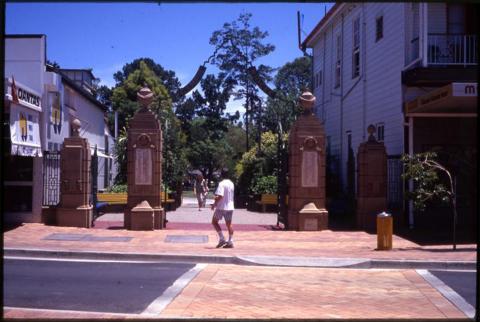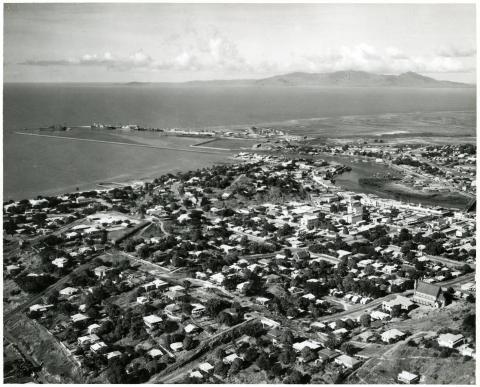
- News of the day
-
Morning Bulletin, Friday 14 July 1939, page 11
Quay Street 749, Rockhampton Ghost Story
(By J.G.)
It's a lone brick building standing on the waterfront in Quay Street. It bears strong evidence of having seen better days. Most of the glass which at one time glazed its windows has gone to be replaced with sheets of iron and bits of weatherboard. Though so old this pile of bricks and mortar has a solid sort of appearance in the sun light of the day; its chipped old plaster face looks knowingly into a mid-day sun and seems almost to whisper a story. To those able to understand, it tells a tale which, for all its improbability, is true. An old man seated near the river bank confirmed a hear-say story which had come our way. Here it is, for what it is worth to you.
Years ago, when Rockhampton's waterfront was a scene of greater activity than it is today, that old house was occupied by a young doctor. His practice was confined mostly to accidents and sickness, connected with the ships which tied up so close to his door, or to the rehabilitating of sailors who had gazed too long, and perhaps too lovingly, on bottles of "Nelson's blood," strong rum, and to which, in the days of iron men and wooden ships the crews of visiting vessels were most partial.
One night, at a time when the water front was quiet and idle, and most of Rockhampton slept, a man was seen to stagger to the door of number 274 and knock. The door opened and the man was admitted to the house. That fact was confirmed by a night watchman from a ship which was moored hard by. The watchman knew the man who had entered the house to be a member of the crew of the ship he was on. He knew the man to be always in trouble on shore, and so for him to visit a doctor at any hour did not surprise the watchman.
A SPLASH, THEN SILENCE
Half an hour later the watchman was not disturbed to hear the front door of the doctor's house open again, and to see the sailor, his arm encased in a white sling, walk straight across the road. He saw the man stand at the old wooden bollard to which the mooring lines of the ship were attached and take off his cap, which he placed on the bollard itself, and, with hardly a pause, walk slowly on to the old wharf, which stands, battered and broken, opposite the doctor's old house today. But what did surprise the night watchman was that the injured man, reaching the edge of the jetty, should turn to face him, and, as though to indicate a farewell, raise his uninjured arm in salutation, then, turning on his heel, walk straight off the jetty into the water; there was a splash - then silence.
THE DOCTOR WAS ABSENT
Then the night watchman got busy. He roused some members of the ship's crew together with an officer. Lights were forthcoming and a thorough search made of the river at the spot where the man had been seen to disappear. The morning sun, rising, found the search still in progress; hour succeeded hour and men looked in vain. The mystery deepened when, on going to the doctor's house for information as to the apparently drowned man's injuries, the doctor was not at home and had not been in the house for many hours prior to the time the watchman had apparently seen the man enter. In fact, when police and ship's officers inquired about him, the doctor proved conclusively that at the time of the supposed visit of the man to the house he had been out of Rockhampton and had remained away from the city for many hours after the man's disappearance.
The doctor lived alone and the house was empty of any living soul during the whole time of the queer happenings. That the watchman had been mistaken seems disproved by two concrete facts. The injured man's cap was found on the wooden bollard and, strongest evidence of all, the owner of the cap was definitely missing; in fact, he was never seen again.
SHIP SAILED AWAY.
Time, tide and ships wait for no man. In due course the ship sailed and here the story might have ended but for one curious thing. The incidents recorded had happened on a cold bleak night in June and during the following year at the same time, and to be exact for every year since, a strange apparition is said to leave that old house by the front door and disappear into the river. This old house stands today a relic of those long-forgotten days. The man who related this story, while not himself remembering those days, vouches for its authenticity. The details, he says, are known to be true by many old inhabitants of this city.
QUAY STREET AT NIGHT.
That is the story; it is given to you as it was passed to me. That there is nothing in it seems highly probably, but, again, is it so improbable?
Stand alone in Quay Street under the trees at night when the city is very still. In the quiet and hushed calmness with which the front of that old house presents itself try to visualise the happening. There is something eerie about the surroundings of that little bit of Quay Street.
For preference, go to the spot on a cold damp night and stand and listen. The softly swirling waters of the river, the drip of raindrops from the trees which line the street, the scurry of a rat as it seeks shelter from the misery of its surroundings, and the ghostly silence of the tumbled down wharf. Then picture to yourself the tread of the missing man across the road to the jetty, the fall into the water, a scream . . . then silence, and still the raindrops from the trees.
- Background
-
Rockhampton was named by Lands Commissioner Henry Wiseman, derived from the rocky bar upstream from the wharf.
/150.5148089,-23.3779675,7/450x450@2x.png?access_token=pk.eyJ1IjoicXNhLWRpc2NvLXFsZCIsImEiOiJjamJmdTgyZXEyeWNjMnlxZm8xcmtieHgxIn0.lmT9J5tTPKGuuccQgCVSAg)



